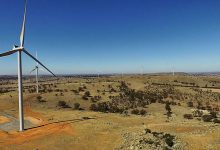Global mining giant Rio Tinto says it has signed the biggest renewable energy power purchase agreement (PPA) in Australia to help supply its huge smelting and refining operations in Gladstone, Queensland.
The deal announced on Wednesday is to take 80 per cent of the output of the 1.4 gigawatt (GW) Bungapan wind energy project which is planned by Windlab, a developer majority owned by iron ore magnate Andrew Forrest.
Remarkably, the PPA is for a 25 year period – likely a record for a wind farm in Australia – and follows news last month of a PPA with what will be the biggest solar farm on Australia’s main grid, the 1.1 GW Upper Calliope solar farm to be built by European Energy.
Rio Tinto has long touted its ambitions to power its Australian refineries and smelters with wind and solar rather than the coal fired generators that supply them now so that they can remain competitive with the global market, both in terms of price and emissions.
“The task remains challenging, but we have a pathway to provide the competitive, firmed power our Gladstone plants need and we are continuing to work hard with all stakeholders, including the Queensland and Australian governments, on getting there,” Rio Tinto chief executive Jakob Stausholm said in a statement.
“Competitive capacity, firming, and transmission, are critical to developing a modern energy system that can ensure more large-scale renewables development in Queensland and help guarantee the future of Australian industry.”
Rio Tinto says that, once developed, the combined 2.2GW of renewable PPAs with Windlab and European Energy have the potential to lower carbon emissions by about 5 million tonnes per year and could generate the equivalent of 10 per cent of Queensland’s current power demand.
The assets that the wind and solar farms will help power include the Boyne aluminium smelter, the Yarwun alumina refinery and Queensland Alumina refinery.
The company says the Bungaban PPA will bring more renewable power into one of Australia’s most important industrial hubs and marks another step towards Rio Tinto’s climate goal of halving its global Scope 1 & 2 carbon emissions this decade.
If combined with more renewable power and suitable firming, transmission, and industrial policy, the Bungaban and Upper Calliope PPAs could also provide the core of a solution to repower Rio Tinto’s three Gladstone production assets.
The Bungaban wind project is located around 40 kms from the town of Wanda, not far from an existing solar farm and big battery project, and 290 kms south-west of Gladstone.
The project is still subject to development and grid connection approvals, but construction is expected to start in late 2025 with production to begin by 2029, in line with Rio Tinto’s renewable ambitions.
Windlab expects the remaining 20 per cent of Bungaban’s output to be sold into the National Electricity Market.
“Securing this PPA is a major milestone for the Bungaban project and a strong signal of the project’s value from the market,” Windlab CEO John Martin said in a statement.
“This agreement highlights the importance of large-scale renewable energy projects in shoring up Queensland’s powerhouse traditional industries, particularly minerals and advanced processing, which employ thousands of people in regional communities across the state and have a key role to play in our nation’s low-carbon future.”
Martin says the project will create up to 600 new construction jobs, inject around $500 million into the regional economy through local employment, supply and contracting, will power the equivalent of 740,000 Queensland homes and eliminate about 4 million tonnes of carbon from the state’s generation profile every year.
Windlab has developed some of Australia’s best performing wind assets, including Coonooer Bridge (pictured) and Kiata wind farms inn Victoria, the Collgar wind farm in W.A. and the Coopers Gap and Kennedy wind farms in Queensland.
The Bungaban wind project is part of what Windlab has called its South Queensland renewable generation hub, and could also include solar and battery projects within the same precinct, which is largely based on cattle properties.
“We’ll have some sort of battery with every project that we build,” Martin told RenewEconomy. He says this would be needed for grid support, but could be bigger if required by customers.
Martin would not reveal the price of the PPA, but says that renewables are “a lot cheaper” than new build coal. Martin says he believes the length of the PPA – 25 years – is the longest ever for a wind project in Australia, and will reduce the cost of capital in the project.
Windlab is 75 per cent owned by Squadron and 25 per cent by Federation Asset Management.
Rio Tinto says it is still seeking more than 1 GW of “reliable power” to support its three main production assets in Gladstone – the equivalent of more than 4 GW of wind and solar power – and could seek more as it electrifies the plant processes at the refineries and smelters.
However, it is likely to pause any further PPAs until it has a clear view of the potential “firming market” – relating to battery storage and pumped hydro – and is talking with governments over the issue.










